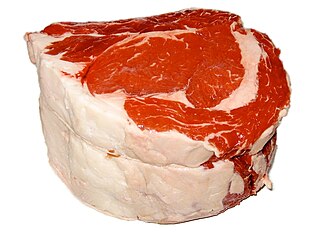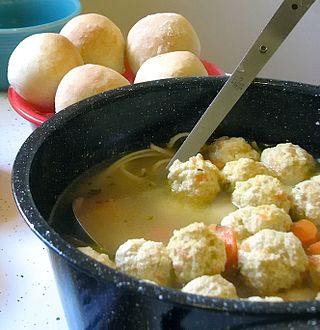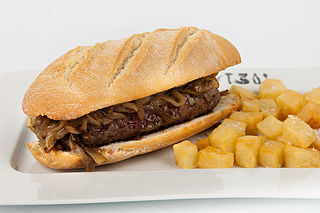
Beef is the culinary name for meat from cattle. Beef can be prepared in various ways; cuts are often used for steak, which can be cooked to varying degrees of doneness, while trimmings are often ground or minced, as found in most hamburgers. Beef contains protein, iron, and vitamin B12. Along with other kinds of red meat, high consumption is associated with an increased risk of colorectal cancer and coronary heart disease, especially when processed. Beef has a high environmental impact, being a primary driver of deforestation with the highest greenhouse gas emissions of any agricultural product.

A hamburger, or simply a burger, is a dish consisting of fillings—usually a patty of ground meat, typically beef—placed inside a sliced bun or bread roll. The patties are often served with cheese, lettuce, tomato, onion, pickles, bacon, or chilis with condiments such as ketchup, mustard, mayonnaise, relish or a "special sauce", often a variation of Thousand Island dressing, and are frequently placed on sesame seed buns. A hamburger patty topped with cheese is called a cheeseburger. Under some definitions, and in some cultures, a burger is considered a sandwich.

An enchilada is a Mexican dish consisting of a corn tortilla rolled around a filling and covered with a savory sauce. Enchiladas can be filled with various ingredients, including meats, cheese, beans, potatoes, vegetables, or combinations. Enchilada sauces include chili-based sauces, such as salsa roja, various moles, tomatillo-based sauces, such as salsa verde, or cheese-based sauces, such as chile con queso.

Meatloaf is a dish of ground meat that has been combined with other ingredients and formed into the shape of a loaf, then baked or smoked. The final shape is either hand-formed on a baking tray, or pan-formed by cooking it in a loaf pan. It is usually made with ground beef, although ground lamb, pork, veal, venison, poultry, and seafood are also used, sometimes in combination. Vegetarian adaptations of meatloaf may use imitation meat or pulses.

Kebab, kabob, kebap, kebob, or kabab (Kashmir) is a variety of roasted meat dishes that originated in the Middle East.

Steak tartare or tartar steak is a French dish of raw ground (minced) beef. It is usually served with onions, capers, parsley or chive, salt, pepper, Worcestershire sauce, and other seasonings, often presented separately, to be added to taste. It is commonly served topped with a raw egg yolk. It is similar to the Levantine kibbeh nayyeh, the Turkish çiğ köfte, the German Mett and the Korean yukhoe.

Kibbeh is a popular dish in the Levant based on spiced lean ground meat and bulgur wheat. Kibbeh is considered to be a national dish of Syria and Lebanon.

New Mexican cuisine is the cuisine of the Southwestern US state of New Mexico. The region is primarily known for its fusion of Pueblo Native American cuisine with Hispano Spanish and Mexican cuisine originating in Nuevo México. This Southwestern culinary style is popular beyond the current boundaries of New Mexico, and is found throughout the old territories of Nuevo México and the New Mexico Territory, today the state of Arizona, parts of Texas, and the southern portions of Colorado, Utah, and Nevada.

Picadillo is a traditional dish in many Latin American countries including Mexico and Cuba, as well as the Philippines. It is made with ground meat, tomatoes, and also raisins, olives, and other ingredients that vary by region. The name comes from the Spanish word picar, meaning "to mince".

Flap steak, or flap meat is a beef steak cut from the obliquus internus abdominis muscle of the bottom sirloin. It is generally very thin, fibrous and chewy, but flavorful, and often confused with both skirt steak and hanger steak.

In Mexican cuisine, cabeza, from barbacoa de cabeza, is the meat from a roasted beef head, served as taco or burrito fillings. It typically refers to barbacoa de cabeza or beef-head barbacoa, an entire beef-head traditionally roasted in an earth oven, but now done in steamer or grill.

Barros Luco is a hot sandwich in Chile that includes beef and melted cheese in one of several types of bread. The sandwich is named after Chilean president Ramón Barros Luco, who served as President of Chile from 1910 to 1915. The sandwich was created in the restaurant of the National Congress of Chile, where president Barros Luco always asked for this sandwich. Other sources point to Confitería Torres as the place where the sandwich was created.
Panamanian cuisine is a mix of Spanish, Indigenous, and African techniques, dishes, and ingredients, reflecting its diverse population. Since Panama is a land bridge between two continents, it has a large variety of tropical fruits, vegetables and herbs that are used in native cooking.

A meatball is ground meat (mince) rolled into a ball, sometimes along with other ingredients, such as bread crumbs, minced onion, eggs, butter, and seasoning. Meatballs are cooked by frying, baking, steaming, or braising in sauce. There are many types of meatballs using different types of meats and spices. The term is sometimes extended to meatless versions based on legumes, vegetables, mushrooms, fish or other seafood.

Kapuska is a hearty traditional Turkish cuisine and Balkan cuisine stew whose name is derived from the Slavic languages word for cabbage. Although the name is imported, the dish is a Turkish version of a cabbage stew common in Russia, Ukraine, Poland and other countries of Eastern Europe. Kapuska is widely known and consumed in the Thrace and Black Sea regions of Turkey.

The pepito is a sandwich prepared with beef, pork, or chicken originating from Spain and also very popular in Latin America. It is a common street food in Venezuela and is also available at some U.S. restaurants. For the beef version, various cuts of beef are used, and myriad additional ingredients can also be used in its preparation.

Keema matar, also rendered Qeema matar, is a dish from the Indian subcontinent associated with the Mughals. The term is derived from Chaghatai Turkic قیمه which is cognate with Turkish kıyma.




























